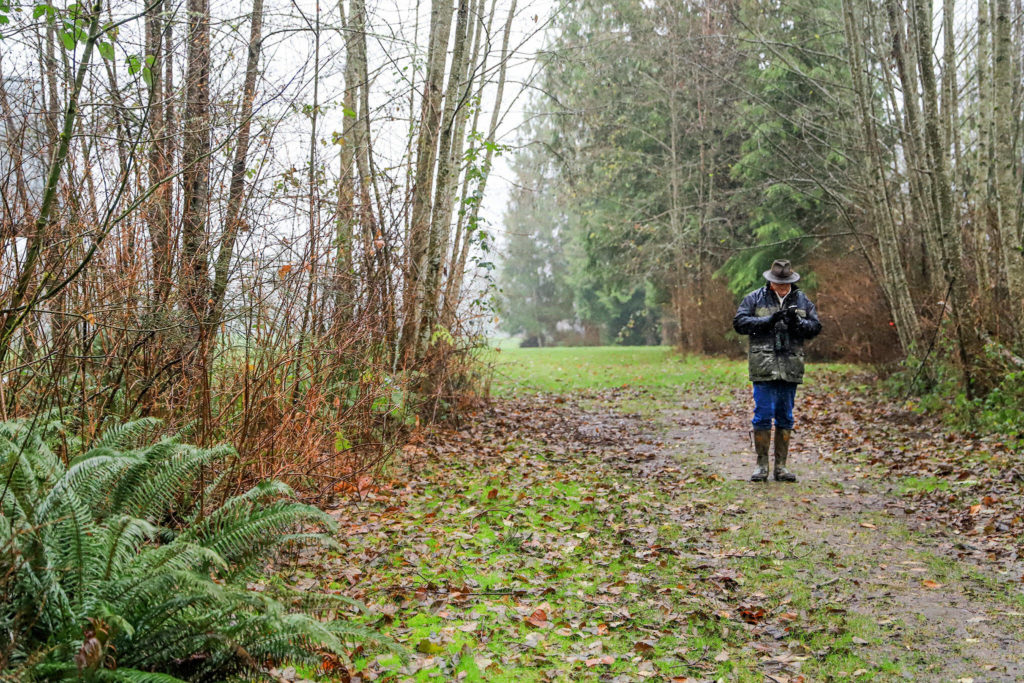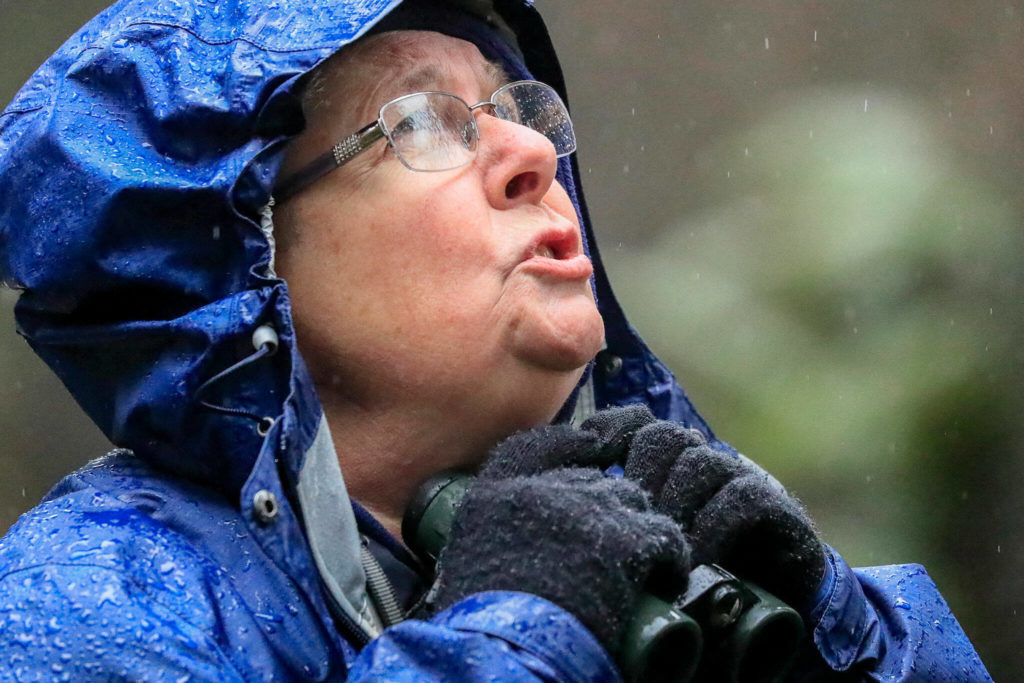SNOHOMISH — Tina Taylor has traveled to every county in Washington, binoculars pointed skyward, searching for birds. So far, she’s tallied 400-some species with her husband, Rick.
In Spokane, she once shimmied through a car sunroof to catch a glimpse of a white-headed woodpecker. While on the hunt for a great gray owl, she made a highway U-turn that, as Rick puts it, “James Bond would be proud of.”
It’s 7:30 a.m. and Taylor has been up for hours, searching for nocturnal owls in the Mill Creek woods. The orange sky is full of crows returning from their communal roosts. They’re the same crows Taylor helped researchers count years ago.
Despite all this, Taylor insists she’s not much of a birder.
Sure, she took a cruise ship to South America just to spot Magellanic and gentoo penguins. And in Washington, the only birds not included on her “life list” — the list of all the species she’s seen — are the once-in-a-lifetime “rare bird alerts.”
Those include a crane native to Japan that was recently spotted near Bellingham. As soon as the couple was tipped off through their birding forums, they booked it north.
Still, Taylor says her husband is the birder of the relationship.
On my quest to find Snohomish County’s birding community, I expected to meet people just like Taylor: folks with lengthy life lists, expansive bird knowledge and stories of far-off bird adventures.
What I didn’t expect is for those people to check all the birder boxes, yet insist they aren’t birders.
Take Susie Schaefer.
It’s New Year’s morning, and Schaefer is in the Marysville library parking lot counting woodpeckers for the 122nd annual Christmas Bird Count, a citizen-led science project wherein volunteers spend 24 hours tallying up as many birds as they can in order to help inform conservation efforts.
When asked about her favorite bird, Schaefer says it constantly changes. Today, she offers up a decisively metal answer: the northern shrike, AKA the “butcher bird.” She explains that the small but deadly species impales birds and other creatures on thorns or barbed wires, saving their bloody meals for later.
Schaefer pauses and turns to another binocular-toting woman. They chat about a quaint bird-themed jigsaw puzzle.
Then she continues: “They’re killer birds.”
At 81, Schaefer moves carefully across the icy asphalt, wearing a purple peacoat and a soft smile.
“I can barely walk,” she says with a laugh. “But I can bird.”
Schaefer recalls a trip to Colombia years back. Armed with bus money and “terrible” Spanish skills, she was determined to see new birds. On a separate excursion to Israel during her conservationist career, she held wooden planks upright to intimidate “doggone ostriches” so they wouldn’t peck at her.
“Oh wow,” she says, lifting her eyes from her shuffling feet. “I had forgotten about that.”
In the 2000s, Schaefer helped save a decades-old Vaux’s swift colony living inside a decaying Monroe elementary school chimney. The town now celebrates the tiny aerialists like guests of honor.
Would Schaefer consider herself a birder? Well, she points to her lack of a life list. After a long career in conservation, the lists irritate her. They seem to turn birds into a selfish indulgence, rather than something to be studied for conservation purposes.
For her, an interest in birds “is about helping others or saving the world.”
“I’m really much more of an environmentalist,” she says.
Wendy Mauch also wouldn’t call herself a birder, or even a bird-nerd (a cheeky identifier avian aficionados sometimes use).
Still, Mauch is highly invested in the fate of her backyard hummingbirds. She has eight feeders hung up at her home between Marysville and Arlington.
During December’s historic cold snap, she MacGyvered a makeshift heater with Christmas lights, zip ties and a thermal lamp to ensure the birds’ sweet sugar-water wouldn’t freeze.
“I’d be so upset if they died,” Mauch tells me. “We’re in the long haul now.”
Mauch got into birds in college, when a roommate inspired her to ditch the pet fish idea and go bigger. She ended up with a blue parakeet named Salty. The little guy went everywhere with her — including the plane ride home to Anchorage.
“He had to be louder than the plane itself,” Mauch chuckles. “It was hilarious. People looking over their shoulders trying to find it.”
Another non-birder? Stanwood resident Ann Kramer.
Kramer spends hours staring at birds. It’s what she was doing for the Christmas Bird Count, where I met her, toting a tripod bird scope across Spencer Island Park.
“You sort of become one with the birds whenever you sit with them,” she tells me, staring at snow geese flying overhead.
As an award-winning photographer, Kramer files intimate bird shots on her website. Dancing, wild-eyed grebes. Burrowing owls clearly whispering secrets to each other. A western tanager stretching to reach a flower like an avian Renaissance painting.
She describes a pair of American kestrels — the continent’s tiniest falcon — sneaking into her back yard to steal live worms (which she’d intended for other backyard birds). The female kestrel found the chow, made sure the coast was clear, and signaled to her mate.
“He’d sit back and wait for her to do all the work,” Kramer says. “Don’t you know relationships like that?”
Her husband Larry mans the scope nearby.
“Men,” he laments, shaking his head.
The bird that started it all for Kramer was an osprey with a video camera in its nest. She watched the livestream for two whole years. Then, in a dramatic turn of events, a bald eagle snatched up the osprey’s chicks.
“Everybody saw it. I had to go into therapy mode,” says Kramer, who did in fact have a decades-long career in family therapy. “I had to counsel hundreds. You know what? You can’t name things. Because nature is harsh.”
Kramer can tell you why hummingbirds are territorial during the day but not at night. She has multiple birding apps and goes on birding walks with the Pilchuck Audubon Society.
But she says “true birders” are more scientific than she is. I listen intently as she describes the mysterious birding community. It sounds like whispers and folklore.
“Birders are all smart,” Kramer says. “They’re fascinating to be around.”
Alas, it proves near-impossible to find a self-identified birder in the wild.
And now, as I scan through hordes of ducks, I wonder: If these locals — with all their bird knowledge and passion — aren’t real birders, then what am I?
I’m tagging along with Kramer and the other Christmas Bird Count volunteers, searching for a rare tufted duck at the Everett Wastewater Treatment Plant. It was a big deal when the male duck was spotted in Everett back in November. Some believe he was blown off-course, perhaps all the way from Europe.
Bird-lovers flocked to nearby ponds, trying to spot his orange eyes and signature slicked-back hairstyle fit for a boyband.
I should be searching for him, too, but I’m distracted by this sudden birder identity crisis.
None of the women I talked to for this story considers themselves birders. They pointed to others more knowledgeable than them. One told me birders are more science-minded than she is, while another said she was too science and conservation-oriented to fit in with the birder community.
My life list consists of a measly 80 or so species scrawled in a notebook. Yet birding is a substantial part of my personality. I’ve dropped too much money on quality binocs and bird tattoos. I spend weekends gleefully listening for my favorite calls and playing gin rummy with bird-themed cards.
And now I’m in north Everett, toughing it through the stench, all for the chance to see some cool birds.
There’s evidence the single tufted duck had a few love affairs during his vacay at Everett’s haven for raw sewage: Local bird nerds have documented ducks here with his same haircut. Those tufted-bluebill hybrids are his legacy.
But I just missed him.
The tufted duck, an exciting “rare bird alert,” proves just as elusive as local birders themselves. And just as intriguing as all these so-called non-birders.
Claudia Yaw: 425-339-3449; claudia.yaw@heraldnet.com. Twitter: @yawclaudia.
Talk to us
> Give us your news tips.
> Send us a letter to the editor.
> More Herald contact information.





























